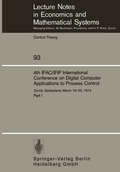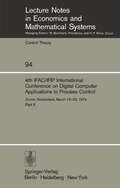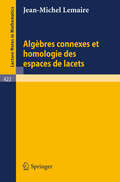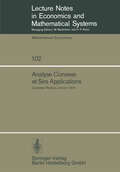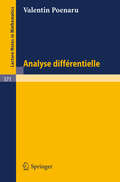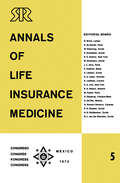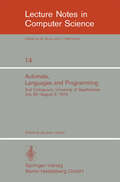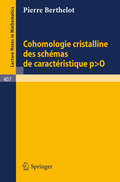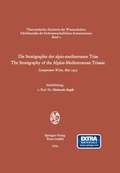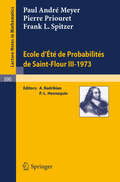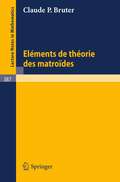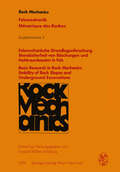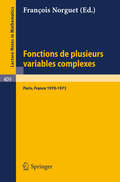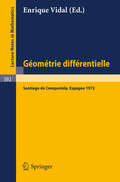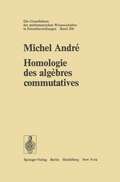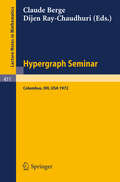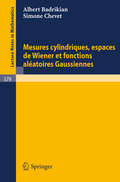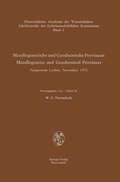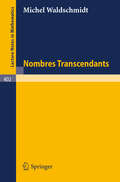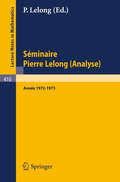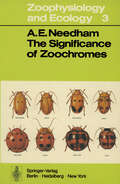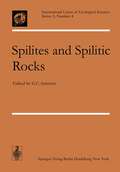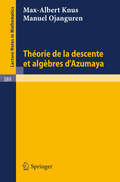- Table View
- List View
4th IFAC/IFIP International Conference on Digital Computer Applications to Process Control: Zürich, Switzerland, March 19–22, 1974 Part I (Lecture Notes in Economics and Mathematical Systems #93)
by M. Mansour W. SchaufelbergerDigital computers have been used more and more to control different industrial processes during the last decade. As of today, many sy stems are designed to include a process control computer as a vital part. The use of computers has created a need for sophisticated me thods for the operation and supervision of complex industrial proces ses. To summarize the state of the art from the practical as well as from the theoretical point of view, the 4th IFACIIFIP International Conference on "Digital Computer Applications to Process Control" will be held at Zurich from March 19 to 22, 1974. The first two vo lumes of the proceedings contain the accepted papers submitted to the conference mentioned above. The papers are arranged according to the topics of the conference. A third volume will include the six follow ing survey papers: 1. Digital Control Algorithms Prof. A. P. Sage, Dallas Texas I USA 2. Interface Problems for Process Control Prof. T. J. Williams, Lafayette Indiana I USA 3. Software for Process Computers Dr. J. Gertler, Budapest I Hungary Dr. J. Sedlak, Prague I CSSR 4. Digital Computer Applications in Metallurgical Processes Mr. W. E. Miller, Salem I USA Mr. W. G. Wright, Schenectady I USA 5. Digital Computer Applications in Power Systems Mr. D. Ernst, Erlangen / FRG 6. Digital Computer Applications in Chemical and Oil Industries Dr. H.
4th IFAC/IFIP International Conference on Digital Computer Applications to Process Control: Zürich, Switzerland, March 19–22, 1974 (Lecture Notes in Economics and Mathematical Systems #94)
by M. Mansour W. SchaufelbergerDigital computers have been used more and more to control different industrial processes during the last decade. As of today, many sy stems are designed to include a process control computer as a vital part. The use of computers has created a need for sophisticated me thods for the operation and supervision of complex industrial proces ses. To summarize the state of the art from the practical as well as from the theoretical point of view, the 4th IFAC/IFIP International Conference on "Digital Computer Applications to Process Control" will be held at Zurich from March 19 to 22, 1974. The first two vo lumes of the proceedings contain the accepted papers submitted to the conference mentioned above. The papers are arranged according to the topics of the conference. A third volume will include the six follow ing survey papers: 1. Digital Control Algorithms Prof. A. P. Sage, Dallas Texas / USA 2. Interface Problems for Process Control Prof. T. J. Williams, Lafayette Indiana / USA 3. Software for Process Computers Dr. J. Gertler, Budapest / Hungary Dr. J. Sedlak, Prague / CSSR 4. Digital Computer Applications in Metallurgical Processes Mr. W. E. Miller, Salem / USA Mr. W. G. Wright, Schenectady / USA 5. Digital Computer Applications in Power Systems Mr. D. Ernst, Erlangen / FRG 6. Digital Computer Applications in Chemical and Oil Industries Dr. H. Amrehn, Marl / FRG We hope, that the publication of these papers from specialists.
Algebres Connexes et Homologie des Espaces de Lacets (Lecture Notes in Mathematics #422)
by J.-M. LemaireAnalyse Convexe et Ses Applications: Comptes Rendus, Janvier 1974 (Lecture Notes in Economics and Mathematical Systems #102)
by J. P. AubinAnnals of Life Insurance Medicine 5: Special Edition Proceedings of the 11th International Congress of Life Assurance Medicine Mexico City 1973
by E. Tanner Swiss Reinsurance Swiss Reinsurance CompanyIn the preface to Volume 1 of the 'Annals of Life Insurance Medicine' Dr. MAX E. EISENRING described the goal of this publication as follows: "Any project which aims at contributing substantially to the modern science of medical underwriting can do so only if the many people preoccupied with these problems throughout the world join forces to the ultimate benefit of those most in need of life assurance." In an endeavour to keep the life insurance medical directors all over the world informed of the developments in the field of life insurance medicine, we have decided to publish the papers which were presented at the 11 th International Congress of Life Assurance Medicine in Mexico in 1973 in Volume 5 of the 'Annals'. We are most grateful to Dr. J. REN06N, President of the Organizing Commit tee of the Congress in Mexico for having consented to our publishing the proceed ings of the Congress in a special edition of the 'Annals'. It is a source of great satisfaction to us that in this way a much larger circle of life insurance medical directors can be reached than would have been the case if only the participants themselves were to receive the proceedings of the Congress. Dissemination of the results of medical research on an international basis, in particular those findings that have a bearing on life insurance medicine, is one of our foremost aims.
Automata, Languages and Programming: 2nd Colloquium, University of Saarbrücken, July 29 - August 2, 1974. Proceedings (Lecture Notes in Computer Science #14)
by J. LoeckxCohomologie Cristalline des Schemas de Caracteristique p O (Lecture Notes in Mathematics #407)
by P. BerthelotDie Stratigraphie der alpin-mediterranen Trias / The Stratigraphy of the Alpine-Mediterranean Triassic: Symposium Wien, Mai 1973 (Schriftenreihe der Erdwissenschaftlichen Kommission #2)
by Helmuth ZapfeOrganisiert im Hinblick auf das Internationale Geologische Korrelationsprogramm (IGCP)
Ecole d'Ete de Probabilites de Saint-Flour III, 1973 (Lecture Notes in Mathematics #390)
by P. A. Meyer P. Priouret F. SpitzerFelsmechanische Grundlagenforschung Standsicherheit von Böschungen und Hohlraumbauten in Fels / Basic Research in Rock Mechanics Stability of Rock Slopes and Underground Excavations: Vorträge des 21. Geomechanik-Kolloquiums der Österreichischen Gesellschaft für Geomechanik / Contributions to the 21st Geomechanical Colloquium of the Austrian Society for Geomechanics (Rock Mechanics Felsmechanik Mecanique des roches. Supplementa #3)
by L. Müller-SalzburgFonctions de Plusieurs Variables Complexes: Séminaire François Norguet Octobre 1970 - Decembre 1973 (Lecture Notes in Mathematics #409)
by François NorguetFunctional Analysis and Applications: Proceedings of the Symposium of Analysis, Recife, Pernambuco, Brasil, July 9 to 29, 1972 (Lecture Notes in Mathematics #384)
by L NachbinGeometrie Differentielle: Colloque, Santiago de Compostela, Espagne (Lecture Notes in Mathematics #392)
by E. VidalHomologie des algebres commutatives (Grundlehren der mathematischen Wissenschaften #206)
by M. Andre(egalite 3. 4). Ce complexe T*(A,B) per met de definir les modules d'homo logie de l'algebre (definition 3. 11) Hn(A,B, W) = Yt,,[T*(A,B)@B W] et les modules de cohomologie de l'algebre (definition 3. 12) Hn(A,B, W) = Yfn[HomB(T*(A,B), W)]. En particulier l'homologie et la cohomologie d'une algebre libre sont triviales (corollaire 3. 36). Quant au module Ho(A,B,B) il est toujours isomorphe au module des differentielles de Kaehler QBIA (proposition 6. 3). Lorsque l'anneau Best un quotient de l'anneau A, la situation est simple en degre 1 (proposition 6. 1) H (A, B, W) ~ Tor}(B, W) I et en degre 2 (theoreme 15. 8, propositions 15. 9 et 15. 12) H (A,B, W) ~ Tor1(B, W)jTor}(B,B). Tor}(B, W). 2 En ajoutant des variables independantes a l'anneau A, il est d'ailleurs possible de se ramener a ce cas particulier (corollaire 5. 2). Dans cette theorie, les modules d'homologie relative sont en fait des modules d'homologie absolue. De maniere precise: a une A-algebre B et a une B-algebre C correspond une suite exacte, dite de Jacobi Zariski (theoreme 5. 1) . . . --+ Hn(A,B, W) --+ Hn(A, C, W) --+ Hn(B, C, W) -+ H _ I (A, B, W) --+ •••• n De cette suite decoulent des relations entre differentielles de Kaehler (n = 0), algebres lisses (n = 1), anneaux reguliers (n = 2) et intersections completes (n = 3). Une autre propriete fondamentale est la suivante (proposition 4.
Hypergraph Seminar: Ohio State University, 1972 (Lecture Notes in Mathematics #411)
by C. Berge D. Ray-ChaudhuriMesures Cylindriques, Espaces de Wiener et Fonctions Aleatoires Gaussiennes (Lecture Notes in Mathematics #379)
by A. Badrikian S. ChevetMetallogenetische und Geochemische Provinzen / Metallogenetic and Geochemical Provinces: Symposium Leoben, November 1972 (Schriftenreihe der Erdwissenschaftlichen Kommission #1)
by W. E. PetrascheckOrganisiert im Hinblick auf das Internationale Geologische Korrelationsprogramm (IGCP)
The Significance of Zoochromes (Zoophysiology #3)
by A.E. NeedhamAs the title indicates, the theme of this book is the functions of biochromes in animals. Recent works on zoochromes, such as those of D. L. Fox (1953), H. M. Fox and VEVERS (1960) and VUILLAUME (1969), have been concerned primarily with the chemical nature and the taxonomic distribution of these materials, and although function has been considered where relevant this has not been the centre of interest and certainly not the basis for the arrangement of the subject matter. Functional significance is a profitable focus of interest, since it is the one theme which can make biochromatology a discrete and integral subject, and because it is the main interest in all biological fields. At present chromatology seems to be a particularly schizoid subject since it is clear that in metabolic functions biochromes are acting in a chemical capacity whereas integumental pigments function mainly biophysically, in neurological and behavioural contexts. It is profitable to attempt an integration by studying the functions of as many chromes as possible, from all aspects.
Spilites and Spilitic Rocks (International Union of Geological Sciences #4)
by G. C. AmstutzThe idea for the present Spilite Volume was born during the Spilite Symposium at the XXIIIrd session of the International Geological Con gress in Prague, 1968. At that time, only a restricted number of petro logists working on spilites was present and, therefore, the group assem bled agreed that a Symposium Volume should also include recent papers by many other spilite specialists. At the same time it was agreed that the papers presented at the Symposium should be returned to the authors for changes and additions. This procedure of upgrading and amending the papers has continued until this year (1973) for various technical and editorial reasons. The information presented here is, therefore, up-to date. To those familiar with the spilite problem it is obvious that the time had come for a review of its state. Also, the existing litera ture had become so voluminous that a monographic review was necessary. Following a modern trend, the authorship for this review was spread among specialists with variable experience. For readers not necessarily familiar with the spilite problem, a brief summary is presented here. A short historical note is followed first by the observations, then by the interpretations, finally by some of the major features of scientific logic as they pertain to the problem of the primary or secondary origin of some of the rocks termed spilites and keratophyres.
